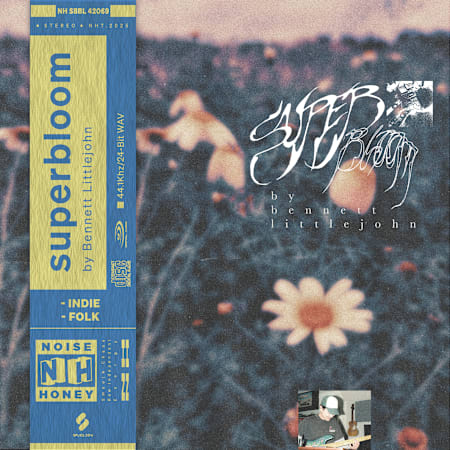/zzzqhnrqpo4kvbehly8t)
Meet Bennett Littlejohn
Bennett Littlejohn is a producer and musician based in Asheville, NC. Originally from Dallas, Texas, Bennett grew up surrounded by country music and the hidden gems of its indie scene. He started out playing bass but quickly expanded his skills to almost anything, diving into recording and producing bands before even finishing high school.
In 2012, Bennett made the move to Nashville, where he honed his skills on pedal steel and played with several up-and-coming country artists. But after too many bar gigs and endless renditions of Wagon Wheel, he began feeling the limitations of being boxed into one genre.
Shifting his focus back to production, Bennett began collaborating with more bands. His work on Hovvdy’s Heavy Lifter and his solo projects under the name Bendrix Littleton allowed his creativity to truly flourish. These records became standouts, showcasing his signature style and opening the door to a wave of new projects.
The next few years were a blur of collaborations, both in and out of the studio. Along the way, Bennett got married and made the move to the Appalachian mountains, where he now calls home.
Over the years, Bennett has worked with artists like Katy Kirby, claire rousay, Hovvdy, Sinai Vessel, Sun June, Porches, Adam Melchor, Advance Base, Dreamer Boy, Zachary Knowles, and Bedroom, to name a few.
These days, his workday could include anything from mixing records, producing projects from start to finish, random additional production, or adding pedal steel to songs. He’s currently building a new home base and studio, and this pack will be one of the last things created in his current space.
A Conversation with Bennett Littlejohn
Q: How would you describe your sound?
BL: I try to be transparent and do what feels inspiring to the project at hand with the folks involved. That said, it's impossible to avoid having a distinct sound. A sum of things you gravitate towards across different projects ultimately creates a ‘sound’. I love papery tape-y textures. I love snare drums that could be a kick drum if they were low-passed. I love to mix things that are two-dimensional with things that are hi-fi and three-dimensional. I also love to have things dynamically change over the course of the song — nothing should stay static. To describe my sound: everything is fair game, but it should always feel dynamic, big, and exciting.
Q: Can you give a brief look into how you create your sounds?
BL: I’m always seeking textures and timbres that are new but still feel familiar. Anything that sparks inspiration is allowed. After spending so much time in traditional Nashville studios, I’ve learned the tried-and-true methods for capturing sound. While those techniques can work, I also choose to step away from them when it feels right. Most of my instruments are vintage, and their unique characteristics shape the sounds I create. I always aim to let the sonic imprint of each instrument guide the creation of each part, rather than resisting it.
Q: How do you hope producers use the sounds in your pack?
BL: There are a few ways this could be exciting for me. Using it as a jumping-off point to create new songs feels great. Drawing from existing progressions to write feels like a fun remote co-write, without even being in the same room. Another approach would be using my textures and timbres to help their song’s freak flag fly. I like to think my pack includes sounds and vibes that are fully unique to Splice, and I’m excited to see what people do with it.
Q: What are some of your pieces of studio gear and why?
BL: The monitoring in my studio is a mix of ATC SMC25As, NS10s, and Auratone 5Cs. While it’s a pretty standard setup — nothing too unique or flashy — it’s something I know I can reference anywhere, and it’ll hold up. Understanding the limits of what works in a mix and being cheeky with those boundaries is smarter than blindly pushing them and hoping for success and repeat clients.
BL: My preamp and microphone collection follows a similar pattern — some provide hyper-accurate, clean representations of the source, while others deliver vibey, saturated captures that evoke a time of pleasing softened transients and bold midrange. Typically, gnarly sounds are most effective when paired with cleaner, prettier ones, allowing the listener to fully appreciate the contrast.
BL: The most indulgent part of my studio is probably my bass collection — it’s the instrument that brings me the most joy. All of my basses, except for one I use for touring, are from the 60s and 70s, and I like to think each one brings something unique to the table. Bass is often overlooked in indie rock, but its timbre and sonic imprint are essential to shaping the finished product. Grabbing a bass (or several) from my rack and experimenting with them during a production almost always brings a smile to my face.
Q: What piece of advice would you give to your younger self starting in music?
BL: Never let anything stand in the way of capturing an inspired performance. A well-treated room with an accurate monitoring system matters far more than a fancy preamp. And don’t take on projects that don’t bring you joy.
/pzhtmageh2lglcbgohed)
/kpibumy1hdankapsew0d)
/vnazl8lxqhjttrera3cv)
From pedal steel in Nashville bars to shaping indie records in the Appalachian mountains, Bennett Littlejohn’s journey reflects his passion for sound and authenticity. His new Splice pack, Superbloom by Bennett Littlejohn, is a vivid reflection of that path — blending folk instrumentation, indie arrangements, and organic textures that capture both familiarity and innovation. Dive into this collection and let its lofi ambience, gritty drums, and melodic charm inspire your next track.


